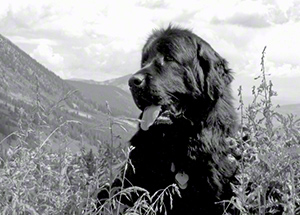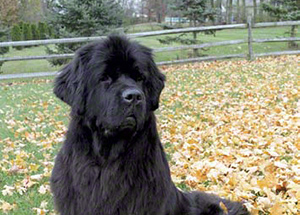My work with dogs is primarily with Newfoundlands. I teach classes that are geared towards teaching owners how to work with their dogs, use common sense and "read" their dog's body language. Although I also teach all breed obedience, what is unique is that I have a "Newfs Only" class and there are a wide variety of breeding programs represented. It is because of this that my husband Ron and I have been able to view various personalities and temperaments. Whether or not you are new to the breed, you may have encountered some of the following personalities.
Dog "A": Ears are flattened back and held tightly against the head. Eyes are alert but do not have a soft expression. When viewing this dog, the words panic stricken come to mind. When out in public, this dog will allow itself to be patted or judged but gives the appearance of a tightly coiled spring. When lying down, this dog is never truly relaxed and is very aware of its surroundings. At home, this dog breathes a sigh of relief to be back in its comfort zone. This dog can be trained and exhibited although an experienced "eye" will pick up the subtle shifting and body language. Nothing about this dog conveys stability.
Dog "B": Ears are up and forward, eyes are confident and will sweep through a group. When this dog walks, his appearance is bold and daring. Nothing phases him and his body carriage says “I’m cool and I know it." This dog will easily challenge both human and animal and is used to getting his or her own way.
Dog "C": Ears are flat against the head and the eyes are almost wild looking. Even when lying down, this dog is aware of every leaf and twig that falls. A subtle movement causes this dog to leap to his feet to sound an alarm. This dog will pant heavily when in public (stressed) and may lunge, snarl and growl at other dogs that it encounters. When it arrives back in the car or at home, it will breathe a sigh of relief and collapse as if in exhaustion.
Dog "D": The ears hang flat and loosely. It walks patiently, observes commotion and ignores it. Eyes are confident and friendly. Body carriage is relaxed and comfortable standing, lying down or trotting. It will alert and assess, not reacting unless necessary. This dog is confident and unflappable. When viewing this dog, the words steady and intelligent come to mind.
Dog "E": Everything about this dog is loose. It snores through commotion, is very placid, and seems to have to reach far into the depths to summon enough energy to walk across the living room. Toddlers falling over it or a dog fight in the next room only elicit a loud groan and stretch. Bump on a log are the words that describe this dog. Animation is seen if a chip bag rattles or the food bowl is brought out.
Dog "F": This dog seems steady, body carriage is relaxed and the eyes do not have a soft expression. It may stare or look right through you. Something about this dog makes you a bit uncomfortable and you find yourself keeping distance between the dog and you. There is nothing tangible that pinpoints your wariness of this dog. It looks like a Newf and seems to act like a Newf but for some reason you are uncomfortable and yes, even a bit afraid.
These are just a few personalities we have encountered in Newf class. Are they all Newf like? Is this temperament or personality? Are these learned behaviors or genetic? I honestly don't know. What I do know is that 70-80 percent of the pup's personality comes from the bitch. This makes sense if you think about the time she spends with her litter and how she reacts to sounds, adults, children, other animals and human contact. The pups learn by watching and imitating her reactions. There is nothing cute about a puppy that growls when picked up and held. Fearful, shy, confident, boisterous, hardheaded and submissive. All of these characteristics and more can be found in a litter.
Faulty temperaments can be viewed as early as five or six weeks of age. Although the pup is young, it will give glimpses to how it will act as an adult. Based on their early observations, a breeder is in the best position to evaluate the litter and make sure the pups will go to homes where the new owners will be aware of what they may encounter as the pup grows. Although personality traits can be enhanced or softened, puppies with faulty temperaments should be euthanised instead of placed in a home.
It has been said that years ago, Newfs didn't have the amount of socializing and training that is now available and they still acted like a Newf should. This may be true, but years ago usually only one person worked outside the household. Behaviors that were questionable were not likely to go unnoticed and were dealt with accordingly.
As the pups grow, a good rule of thumb is to expose the pup to everything you think it might encounter as an adult. This should be done BEFORE one year of age. The new owner should attend a puppy class and then a basic obedience class. This helps the pup learn how to socialize with other dogs, other breeds, and exposes them to the sights and sounds that go along with riding in a car, traffic in parking lots, doors slammed, the echoes in a building, different flooring, general commotion, and being handled by other people. This is also where the dog owner will learn to correct unwanted behaviors and learn to set boundaries and limitations. These are all things that if the pup is to be shown, will make him confident and take these sights and sounds in stride. If the dog is to be a pet, all the more reason for exposure.
Some of the dogs that we see have had no consequences for their actions and easily out think their owners. I have also come across dogs that act mentally challenged to get out of doing an exercise or action.
The puppy owner needs to remember that first and foremost their puppy is a dog. Unlike smaller breeds, the window of opportunity for training a Newfoundland, while he or she is manageable, is small. As a giant breed, they seem to grow literally overnight. Obnoxious behavior that is excused in a small breed is an accident waiting to happen when it occurs with a dog the size of a Newf.
Some dogs that we encounter have missed that golden window and still act very Newf-like. Others have had minimal exposure and act like other breeds. Although behaviors can be altered, softened or enhanced, the key is not only breeding sound-minded animals. The Newf owner MUST take responsibility to socialize and train their dog.
reprinted from NewfTide 1999

